Research
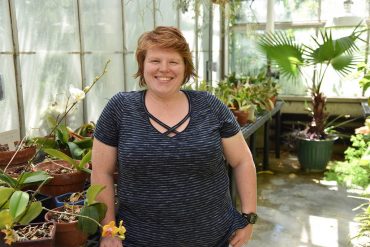
July 5, 2017
The Necessity of Fungi
Graduate Researcher Sarah Unruh explores the essential role of fungi in orchid germination By Emily Kummerfeld | Bond LSC Graduate Researcher Sarah Unruh | photo by Emily Kummerfeld, Bond LSC The blooms of orchids are unmistakably beautiful, and how they reproduce has fascinated biologists for centuries. But, orchids might not even exist if not for the help of fungus. Up to 30,000 species of orchids require the intervention of fungi since their seeds do not contain the necessary nutrients to sprout. Sarah Unruh, a fifth-year biological sciences PhD student in the lab of Bond LSC’s Chris…
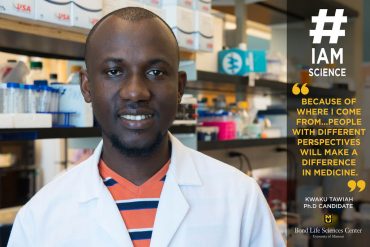
June 27, 2017
Kwaku Tawiah #IAmScience
Kwaku Tawiah, a Ph. D candidate in biochemistry at MU, stands near his lab station in the Burke Lab in Bond LSC. | photo by Mary Jane Rogers, Bond LSC By Mary Jane Rogers | Bond LSC “#IAmScience because of where I come from. If you look at Africa, we have some of the most dangerous infectious diseases in the world…When you see these diseases first-hand and the havoc they cause, you want to solve the problem. People with different perspectives will make a difference in medicine.” Growing up in Ghana gave Kwaku Tawiah a different…
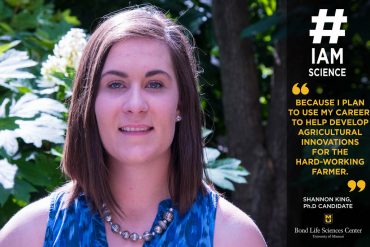
June 21, 2017
Shannon King #IAmScience
Shannon King, a Ph.D candidate in the Biochemistry department at MU. She works in Scott Peck’s lab at Bond LSC. | Photo by Mary Jane Rogers, Bond LSC. By Mary Jane Rogers | Bond LSC “#IAmScience because I plan to use my career to help develop agricultural innovations for the hard-working farmer.” Most of Shannon King’s support system – her friends, grandparents, and boyfriend – are all farmers. They’re her inspiration and part of the reason her career goal is to use science to help farmers. She’s currently a Ph.D candidate in the Biochemistry department at MU…
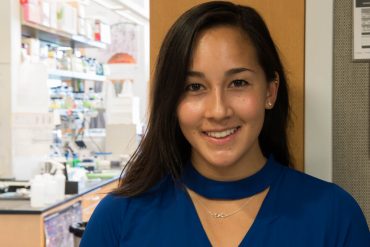
June 21, 2017
A step into summer research
Jacqueline Ihnat, one of the 12 Cherng Summer Scholars, outside Dr. Cornelison’s lab at the Bond Life Sciences Center. | Photo by Mary Jane Rogers, Bond LSC Sometimes the most learning occurs outside of the classroom. For Jacqueline Ihnat, an opportunity to pursue research at the Bond Life Sciences Center this summer will give her that chance. She recently became one of 12 Cherng Summer Scholars, a full-time, ten-week program within the Honors College at MU. “Doing research helps keep me focused on the bigger picture,” Ihnat said. “Sometimes in class we learn things that don’t…
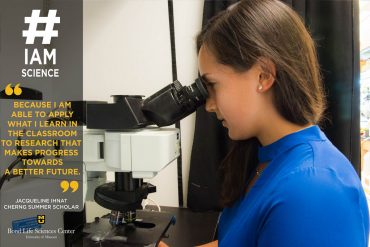
June 14, 2017
Jacqueline Ihnat #IAmScience
Jacqueline Ihnat, one of the 12 Cherg Summer Scholars chosen from within the Honors College at MU in 2017. | Photo by Mary Jane Rogers, Bond LSC By Mary Jane Rogers | Bond LSC “#IAmScience because I am able to apply what I learn in the classroom to research that makes progress towards a better future.” Jacqueline Ihnat was recently selected as one of the 12 Cherng Summer Scholars within the Honors College at the University of Missouri. This scholarship provides her with $8,000 to fund her summer research. She’s fascinated with cells and how our bodies…
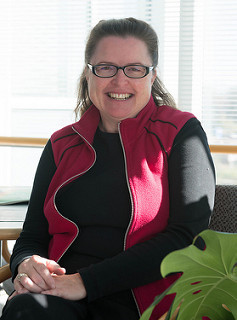
June 7, 2017
The evolution of a corn geneticist
By Jennifer Lu |Bond LSC Paula McSteen is a professor of biological sciences at MU and a researcher at the Bond Life Sciences Center. | Photograph by Jennifer Lu, Bond LSC When developmental plant geneticist Paula McSteen thinks about the specimens she studies, one word comes to mind: potential. She thought it as she stood in the midst of the first corn field she ever planted as a post-doctoral fellow in corn genetics. She thinks it as she counts kernels from corn crosses that will be sent to Hawaii, a hotspot for corn geneticists looking to…
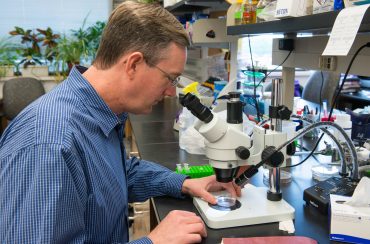
May 24, 2017
Small steps to treat neuromuscular disorder
Researchers find evidence of a genetic modifier that can improve symptoms of Spinal Muscular Atrophy Chris Lorson examines axons through a microscope. Lorson’s lab recently published results that showed evidence that the protein plastin 3 affects the severity of SMA. | Photo by Eleanor Hasenbeck, Bond LSC Eleanor Hasenbeck | Bond Life Sciences Center Two new potential treatments might improve the lives of patients living with Spinal Muscular Atrophy. Researchers in the Lorson lab at Bond Life Sciences Center recently produced a new drug that increases the lifespans of mice with SMA, and they found…
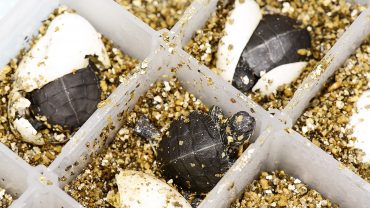
May 15, 2017
BPA rewires the sex of turtle brains
By Jinghong Chen | Bond Life Sciences Center Painted turtle eggs were brought from a hatchery in Louisiana, candled to ensure embryo viability and then incubated at male-permissive temperatures in a bed of vermiculite. Those exposed to BPA developed deformities to testes that held female characteristics.Photo by Roger Meissen | © 2015 – MU Bond Life Sciences Center Cool dudes, hot mommas. This is the underlying concept behind sex development in painted turtles, a species that lacks sex chromosomes. A painted turtle’s sex is determined by temperature at which the eggs are incubated at…
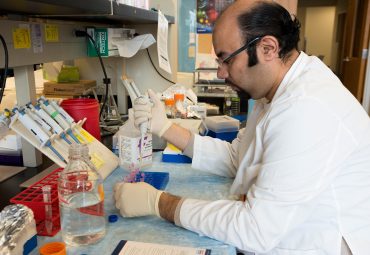
March 23, 2017
Why self-defense turns self-attack
By Jinghong Chen | Bond Life Sciences Center Mahmoud Khalafalla, a Ph.D. student at Weisman’s lab, is isolating RNA from salivary glands of Sjögren’s syndrome mouse model to look for the expression of pro-inflammatory genes. | photo by Jinghong Chen, Bond LSC Our immune system is often the key to our health. Everyday, it works to protect us from foreign invaders such as bacteria and virus, but what happens when it attacks our own tissues? Gary Weisman, a Curator’s Distinguished Professor of Biochemistry at the Bond Life Sciences Center, is working to advance our understanding of…
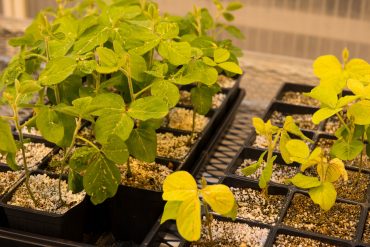
March 17, 2017
Planting a seed for sciences
Jinghong Chen | Bond Life Sciences Center Plants on the left grow with rhizobia bacteria, one type of fixing nitrogen bacteria, in the greenhouse, while the plants on the right grow without the bacteria. | photo by Jinghong Chen, Bond LSC Since eight years old, Beverly Agtuca knew she wanted to be a scientist. A trip to Philippines changed Agtuca, an American-born Filipino, and inspired her passion on plants. “My grandma always told me to work in the field all day so that they can have enough food for us to eat,” Agtuca said. “The life…
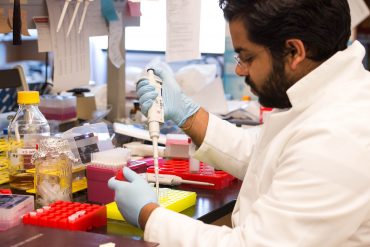
Feb. 17, 2017
Art of balance
Jinghong Chen | Bond Life Sciences Center Vinit Shanbhag mixes the CRISPR plasmid DNA with cells. The lab will test whether the gene of interest has been knocked out of the cells later. | photo by Jinghong Chen, Bond LSC It might be strange to say, but in a way the Australian soil led scientist Michael Petris to where he is now. In certain areas of Australia, soils suffer from extremely low level of copper bioavailability, resulting in poor growth and neurological problems on sheep. Petris, a Bond LSC investigator and professor of biochemistry who was…
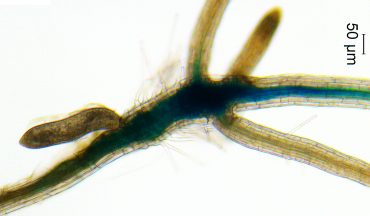
Feb. 10, 2017
Chemical persuasion
Scientists prove parasite mimics key plant peptide to feed off roots By Roger Meissen | Bond LSC A nematode (the oblong object on the left) activates the vascular stem cell pathway in the developing nematode feeding site (syncytium) on a plant root. | photo by Xiaoli Guo, MU post-doctoral research associate When it comes to nematodes, unraveling the root of the issue is complicated. These tiny parasites siphon off the nutrients from the roots of important crops like soybeans, and scientists keep uncovering more about how they accomplish this task. Research from the…